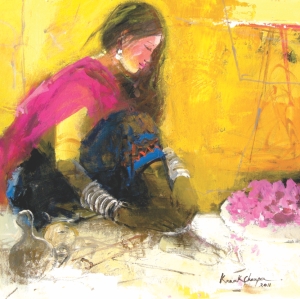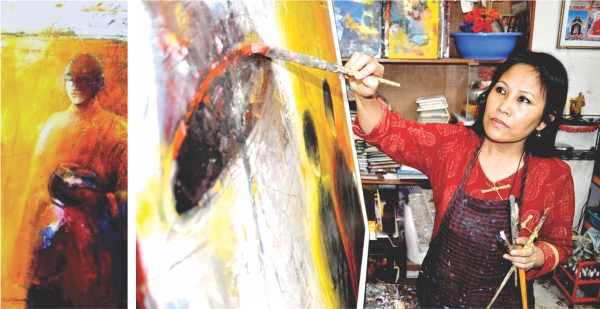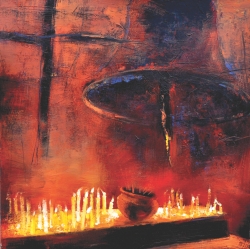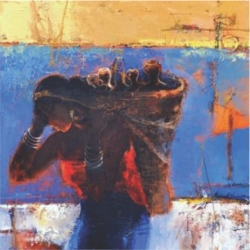| Home - Back Issues - The Team - Contact Us |
 |
| Volume 10 |Issue 42 | November 04, 2011 | |
|
|
Profile Joi de vivre of the Hill Tracts Fayza Haq
It was not easy for Kanakchampa Chakma to have pirouetted to the position of having works that are so sought after that most of it is sold off even before they reach the gallery. Kanak says, "I've had to struggle and sweat it out to reach this position. The reason for this, I believe, is that I've got competition from the male painters – after my work had the largest sale among the female artists. It was a struggle for me, when other artists couldn't quite take my success easily. As my paintings were popular among my buyers, my sales didn't go down, despite the professional rivalry, and natural jealousy." Kanak's theme has been the ethnic people from the Hill Tracts: their butterlike complexion, gorgeous straight tresses, their chunky, silver jewellery, the men with muscular bodies. As they dance or play flutes, with eye-catching head bands and decked with bird feathers—they bring in all the life and living of these spirited people. They are born free, and wish to be left in peace and harmony. The bathing of the young, beauteous women —as one saw in the paintings of Gauguin from the South Sea Islands – are nonpareil. They have the backdrop of the houses on bamboo poles, with skidding clouds behind. Women doing “Jhum Chaash” and weaving colourful clothes, the “Penong” and its accessories are brought in too. These are done on large scales, very often, and take up quite a bit of living-room wall space.
In the Hill Tracts society, a generation back, it was the women who worked. The effect is full of happiness and tranquillity. The hills, sky and gently flowing rivulets and included on the canvas, and sometimes, on paper—as seen once at “Saju's Gallery”. Thus, man is seen against the backdrop of nature. Peace and harmony is the message. The innocent Hill Tracts inhabitants, untouched by civilisation and industrialisation, are not speeding ahead, in the call for progress. What is found in Kanak's work is inspired by nostalgia and euphoric dreams of contentment.
What was the background for the Chakma girl, who captured the imagination of viewers, both local and from abroad? Kanak says that the artistic sensibility is in her genes. Her mother, who sometimes comes by from her village home, now that Kanak's father has passed away, won may coveted prizes from UK, during the 60s and 70s. Her mother is a weaver, receiving awards and accolades for her weaving from London and Italy, having shows of her own in the European capitals. She has won prizes for her art in Bangladesh too. Having studied at the Dhaka Art College, more than 25 years back, comparing her student days with the present day upcoming artists, Kanak says, that in her times, they did many more outdoor sketches and studies. The art students did not rely on cameras or computerised images.
Married to a busy filmmaker Khalid M Mithu and the mother of two teenagers, Kanakchampa like many women has learnt to manage both family and work very astutely. Both her children have won awards for their documentaries and Kanakchampa cannot help but acknowledge their achievements with pride: "My daughter, Shiropa, a prize-winning thirteen year old, has travelled to different countries to make films like her brother. My son Arjushresto, has won 13 international awards as film-maker, while my daughter has won five times. The talented two won prizes from Finland (2006) the US, Iran etc; my daughter won an award on her film on children and on gypsy life and gypsy life. The two also went as judges." Although her family is anything but usual, Kanak tries to create a normal environment for her children. She is a devoted wife and loving mother while at the same time keeps busy painting amazing pieces of art that reflect the soul of the land that she is from.
Copyright
(R) thedailystar.net 2011 |
||||||||||



